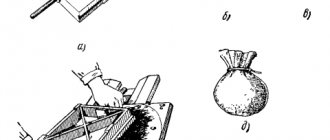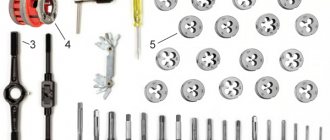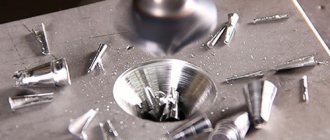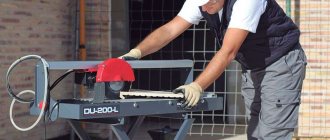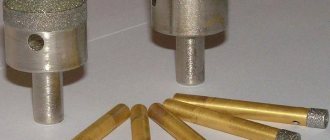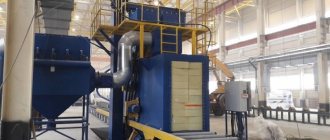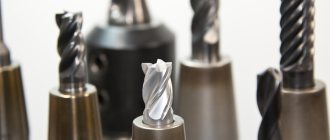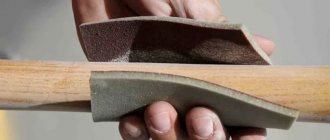The scraper is well known to plumbing experts. Using this tool for surface finishing, metal parts can be given a minimum degree of roughness, and their geometric parameters can be given a high degree of accuracy.
Scraping the lathe tailstock guides
How is scraping done?
The word “scraping” itself, which can be translated as “scraping”, came to us from Germany. It very accurately corresponds to the essence of the technological operation that it denotes. During this operation, irregularities are scraped off the surface of the part, which makes it as smooth as possible.
The scrapers used to perform this operation are made of tool steel. The design of this tool consists of a four- or triangular-shaped handle and a cutting part. To give the working part of the scraper the required degree of hardness (64–66 HRC units), it is subjected to hardening.
Doctors are made mainly of standard length (20–40 cm), and the width of their cutting edge depends on the type of operation being performed. Thus, rough scraping is performed with a tool whose working part width is 20–30 mm; for finishing scraping, this interval is 15–20 mm.
The type of scraping performed also influences the angle of the tip that should be formed on the tool. Plumbing experts recommend using the following sharpening angles for the cutting tip:
- 75–90° – for roughing;
- 90° – for finishing scraping;
- 90–100° – for finishing operations.
It should be borne in mind that the sharpening angle of the cutting edge of the scraper is measured relative to its axis.
Sharpening depends on the shape of the working part of the scraper
The geometric parameters of the tool for scraping are not regulated by any GOST, although many, out of ignorance, try to find such data in the standard under number 1465-80. Meanwhile, GOST 1465-80 refers to files and has nothing to do with scrapers. As for the scrapers themselves, in the relevant GOSTs one can find only the requirements for the metal for their manufacture, as well as for the rules for accepting such a tool belonging to the metalworking group.
Secrets of caring for files
Like any other hand tool, the hog file should be looked after in a timely manner, thereby significantly extending its service life. Despite the use of metal, the bastard file is very fragile. The main recommendations are the following:
- Hitting metal objects is not allowed. This rule must be observed at the time of work and storage. Most often, damage occurs when all the tools are dumped into one box. The ideal choice is to use a special box with various slots, which are designed to store individual tools.
- Experts prohibit placing a garnish file on a metal surface. This is due to the fact that in such a case you can lose some of the teeth. If work is carried out frequently, then you need to prepare a special wooden stand in advance. This material is softer and suitable for this application.
- The product should be stored away from high humidity. This is due to the fact that moisture causes corrosion, which significantly reduces the service life.
- Do not allow the product to come into contact with any lubricants. Some people lubricate the surface to eliminate the possibility of corrosion, but this is a serious mistake. Removal of metal from a surface is accomplished by friction, and lubrication reduces efficiency.
- It is not recommended to carry out work involving removing scale with a file. This is due to the fact that the special properties of the metal cause the grooves to quickly become dull. If there is no other tool at hand, then it is recommended to choose an old draper file.
- The service life of the product in question can be significantly increased due to its first use in the processing of soft materials. Only after this they begin to work with hard alloys. In addition, you cannot use a hog file to work with materials for which it is not intended.
- If a tool is purchased for processing soft alloys, it is recommended to cover the working surface with chalk. This eliminates the possibility of chips sticking. This problem often causes a significant decrease in the effectiveness of the treatment. If you do not take any action before actually performing the work, then cleaning the chips afterwards will be very difficult, especially when working with soft alloys.
- A situation often occurs when the surface of a hog file is covered with a large amount of oil. This problem can be solved by cleaning the surface with charcoal.
Compliance with a relatively small number of recommendations can significantly extend the service life of a wormwood file. It is worth considering that even a minor defect can significantly reduce the service life.
Types of tools for scraping
Today, specialists use various types of scrapers, differing from each other in several parameters. One of these parameters is the shape of the cutting part of the tool, depending on which scrapers are divided into flat, triangular and shaped. Unlike flat and triangular type tools, shaped scrapers have a working part that completely follows the shape of the surface of the workpiece.
Scrapers with various working parts
Triangular scraper with wooden handle
A tool, the working part of which has several edges, mainly processes cylindrical and concave surfaces, and flat scrapers successfully cope with the processing of various grooves and grooves. In practice, disc and ring-shaped scrapers are often used. With the help of the former, parts with wide surfaces are processed, and the latter are used for scraping products that have a round shape.
According to their design, scrapers can be one-piece or dismountable, single- or double-sided. More durable are double-sided scrapers, which differ from single-sided scrapers in that they have two working parts located on both sides of the handle.
Composite scraper device
The working part of the scraping tool, according to its location relative to the handle, can be flat or curved. Scrapers, the working part of which has a curved shape, are most conveniently used for processing soft metals, as well as parts with sharp corners.
Relatively recently, only hand scrapers were used in plumbing, but today many manufacturers offer tools equipped with a pneumatic or electric drive. You still have to manipulate such a tool manually, but this requires much less effort than when using a hand scraper.
Universal scraper BIAX
Rasp
A rasp should be included in a separate category of tools. In many ways it resembles the bastard file, but is characterized by its own specific characteristics. Examples include the following:
- The flat version of the bastard file is often used for working with concave surfaces.
- Modern flat rasps are equipped with comfortable handles, which greatly simplify the task of surface processing.
- There are also round rasps. They are supplied with two-component handles. Due to the round cross-section, it is possible to process various holes that have an uneven surface.
To work with such a tool, no special skills are required. The quality of the obtained result can be significantly improved by pre-fixing the product in a special vice.
In conclusion, files are an important tool that is found in almost all mechanics' kits. There are many different sets on sale, so there are no special problems with choosing. Recently, the most in demand is the product of foreign manufacturers, since the declared characteristics almost always correspond to the real ones. When purchasing, it is recommended to conduct a visual inspection, as even minor defects should be absent.
Areas of application for scrapers
Using a scraper, a specialist removes the thinnest layer of metal from the workpiece, the thickness of which can vary between 0.005–0.7 mm, which allows the degree of surface roughness to be brought to the required level. With the help of such a technological operation, parts are often processed that will subsequently mate and move relative to each other. The most common parts for finishing which various types of scrapers are used are:
- parts of machine tools and high-precision instruments;
- elements of sliding bearings;
- various measuring instruments and devices for carrying out control operations;
- blades of cutting tools (to sharpen them, a so-called sharpener-scraper is used).
Scraping - finishing the lathe slide guides
One of the advantages of scrapers is their versatility, so their scope of application is not limited to the above points. Using such tools, they perform engraving work on the surface of soft materials, process the edges of parts, and remove old coating. They have also found application in cosmetology; manicurists use them to perform their manipulations.
The scrapers used to solve various problems can be distinguished from each other even by photos, since they have different designs and geometric parameters. Thus, a miniature manicure tool is made in the form of a spatula with a comfortable handle, and devices for scraping large workpieces can be produced in the form of carbide plates. It is quite difficult for a non-specialist to guess that such a plate is a scraper, even if he sees it in person and not in a photo. To use this tool, you need a special lock, equipped with a comfortable handle for performing metalwork manipulations.
The scraping technology depends both on the size and configuration of the workpiece, and on the hardness of the material from which it is made. A specialist who is going to perform such a technological operation must correctly select the sharpening angle of the working end part of the scraper relative to its axis. When processing different materials, this angle must be within the following limits:
- when scraping soft metals – 35–400;
- when processing the surfaces of steel parts – 75–900;
- when performing scraping of parts made of cast iron and bronze - more than 900.
Purpose
A hog file is used to remove a layer of material of large thickness (up to 0.15 mm) from the surface of a workpiece in one pass of the tool as a result of a reciprocating movement. This effect occurs due to the presence of relief notches on the canvas of the product, forming sharp teeth. The fewer notches applied per unit length of the product, the larger the tooth. Bruiser files have the coarsest notch.
The following operations are performed with files:
- cleaning electrical contacts;
- sharpening of other tools;
- removal of burrs and scale;
- removing dirt, rust and old paint;
- adjusting parts to size.
The grooved surface provides a specified level of precision and cleanliness with minimal physical effort.
